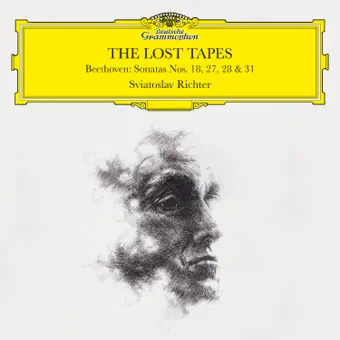september 2025
Beethoven: Sonatas Nos. 18, 27, 28 & 31 (The Lost Tapes / Live)
Sviatoslav Richter
Ontdek Richters Beethoven opnieuw dankzij deze vijf verloren gegane uitvoeringen uit 1965. Deze door de DG uitgegeven liveverslagen vormen een waardevolle aanvulling op onze kennis van een van de grootste pianisten uit de 20e eeuw.

Wie eraan twijfelt dat Sviatoslav Richter een van de meest opgenomen muzikanten in de geschiedenis was, hoeft slechts een vluchtige blik te werpen op de discografie van Ates Tanin. De meest recente uitgave, daterend uit augustus 2006, is ronduit adembenemend, zowel wat betreft de enorme hoeveelheid opnames als de vele opnames van individuele werken. En omdat Richter nooit warm liep voor wat hij de steriliteit van de studio noemde, bestaat het grootste deel van deze enorme erfenis opmerkelijk genoeg uit live-opnames. Richter liet van elk van de hier opgenomen sonates meerdere opnamen na: 23 van Op. 31 nr. 3, 12 van Op. 90, 17 van Op. 101 en 30 van Op. 110. Toch is de waardering die Richter onder pianisten geniet, alleen maar toegenomen in de 28 jaar sinds zijn dood in augustus 1997 op 82-jarige leeftijd. Daarom trekken deze nieuwe opnamen van uitvoeringen uit de jaren 60 in La Grange de Meslay bij Tours en in Luzern de aandacht.
De grootse sonate in Es-groot van de set Op. 31 is verbluffend. Het zonnige openings-Allegro ontvouwt zich met een briljante helderheid die niet bezuinigt op drama. Richters arsenaal aan toets is te zien in het Scherzo van Allegro vivace, het vrolijke thematische materiaal dat wordt geaccentueerd door de staccato-energie van een virtuoze begeleiding. De sensuele lyriek van het Menuet is volkomen ontwapenend, en de luxueuze rust vormt de basis voor de finale, een adembenemende en opwindende tour de force die je in elke Beethoven-uitvoering tegenkomt.
Richters talent voor het weergeven van de meest levendige contrasten komt volledig tot zijn recht in de rauwe ambivalentie van de opening van Op. 90, voordat alles wordt verzacht en verzoend in deze meest Schubertiaanse van alle sonatedelen van Beethoven. Op. 101, die Richter moeilijker vond dan alle daaropvolgende sonates, waaronder het Hammerklavier, is nobel in zowel concept als uitvoering. Het Allegretto strekt zich uit en beweegt zich van nuance naar nuance, zijn mijmering abrupt onderbroken door de verfrissende mars. Vanaf dat moment, ongeacht iemands bekendheid met het stuk, komt elk nieuw uitzicht als een verrassing, zo niet een openbaring. Er zijn vast maar een handvol interpretaties die zo diep doorvoeld en prachtig uitgevoerd zijn.
Eindelijk aangekomen bij Opus 110, betreden we de verheven sferen van voortreffelijk cantabile spel, getemperd door fantasie. Dan, tot mijn spijt, wordt de betovering verbroken door een Scherzo dat zo vlak en ritmisch grof is, zo dynamisch overdreven dat het de hele sonate dreigt te verdrinken. Gelukkig is het Adagio, met zijn Arioso dolente die de fuga's inluidt, zo volledig meeslepend dat het evenwicht en de samenhang worden hersteld.
Over het geheel genomen vergeet men bij zo'n fantasierijke muziekproductie de niet bepaald optimale klank van de instrumenten. Het is heerlijk om Richter weer te horen.

Anyone who doubts that Sviatoslav Richter was one of the most recorded musicians in history need only cast a cursory glance at Ates Tanin’s discography. Its most recent iteration, dating from August 2006, is little short of breathtaking, both in the sheer quantity of recordings and the multiple recordings of individual works. And because Richter never warmed to what he considered the studio’s sterility, the bulk of this vast legacy remarkably consists of live performance recordings. In fact, Richter left several recordings of each of the sonatas included here: 23 of Op 31 No 3, 12 of Op 90, 17 of Op 101 and 30 of Op 110. Yet the esteem in which Richter is held by pianists has only risen in the 28 years since his death in August 1997 at the age of 82. That is why these new recordings of performances from the 1960s at La Grange de Meslay near Tours and in Lucerne command attention.
The grand E flat major Sonata of the Op 31 set is stunning. The sunny opening Allegro unfolds with brilliant clarity that doesn’t stint on drama. Richter’s arsenal of touch is on display in the Allegro vivace Scherzo, the jaunty thematic material set off by the staccato energy of a virtuoso accompaniment. The sensual lyricism of the Minuet is completely disarming, its luxurious repose setting the stage for the finale, as breathless and exhilarating a tour de force as you’re likely to encounter in any Beethoven performance.
Richter’s gift for portraying the most vivid of contrasts is given full rein in the craggy ambivalence of the opening of Op 90, before all is ameliorated and reconciled in this most Schubertian of all Beethoven’s sonata movements. Op 101, which Richter considered more difficult than all the subsequent sonatas, including the Hammerklavier, is noble in both concept and execution. The Allegretto stretches and arcs from nuance to nuance, its reverie abruptly halted by the bracing march. From there, regardless of one’s familiarity with the piece, each new vista comes as a surprise, if not a revelation. Surely there are only a handful of interpretations so deeply felt and beautifully executed.
Arriving finally at Op 110, we enter the lofty climes of exquisite cantabile playing, mitigated by flights of fantasy. Then, I regret to say, the spell is broken by a Scherzo so flat-footed and rhythmically crude, so dynamically overblown that it risks sinking the entire sonata. Luckily the Adagio, with its Arioso dolente ushering in the fugues, is so completely arresting that equilibrium is regained and cohesion restored.
Overall, in the face of such imaginative music-making, one forgets the less than optimal sound of the instruments. It’s wonderful to hear Richter again.
